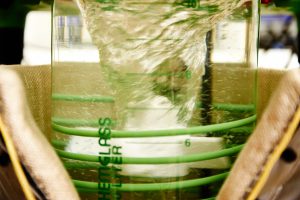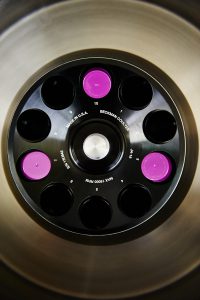By Judah Martin and Adam Jones
Photos by Matthew Wood

When it was discovered that using magnetism could yield images inside the body, it was lauded as a medical breakthrough. Still, in the more than 60 years since magnetic resonance imaging, MRI, was first discovered, it has continually been improved to diagnose patients.
By tinkering with the properties of a common chemical compound, Dr. Yuping Bao, a University of Alabama engineering professor, believes MRIs can be further enhanced.
Either orally or through injection, patients scanned through the MRI first take a chemical to help the MRI take a better picture. Without the use of a chemical contrast agent, certain parts of the body appear dark and unclear on an MRI scan. This prompted scientists to develop a gadolinium-based contrast solution that illuminates the area of the body intended for study in the images.

However, this once-celebrated MRI solution has flaws and is the subject of numerous FDA tests investigating its role in causing disorders like nephrogenic systemic fibrosis, or NSF. Already a threat to patients suffering kidney or liver disease, the notably small size of the gadolinium complex exacerbates its potential to cause harm, allowing it to easily escape its intended route through the patient’s bloodstream. When this mishap occurs, the patient must consume yet more of the contrast agent – in an effort to produce a clear scan – thereby increasing their chances of experiencing adverse side effects.
Safer contrast agents for those with kidney or liver problems are tiny balls of iron oxide, yet they don’t circulate in the blood as long and end up in the liver and spleen. Therefore, these particles are primarily used for liver and spleen MRI scans.
Bao and Thomas Macher, a former graduate student in Bao’s lab, believe they have found a solution to the problems of both contrast agents. Bao, who has studied nanomedicine since graduate school, began working on the alternative contrast agent in 2009.

Bao researches the integration of biology and nanomaterials, particularly working with magnetic iron oxide nanoparticles. Swapping the chemical groups that originally coat iron oxide nanoparticles and making these particles soluble in water shows great promise for medical applications such as drug delivery and medical imaging. In 2011, the discovery led to a publication highlight in the scientific journal Nature.
Bao’s work shows iron oxide nanoparticles formed into a wire shape can enhance MRIs. These nanowires could potentially offer both a solution to MRI patients with liver or kidney problems and typical patients. Their shape is significant.
“Normally if you talk about nanoparticles, people will say they are spherical,” Bao says.
And in that standard, spherical shape, the iron oxide nanoparticles produce darker, more obscure images than a scan using the traditional contrast agent, in addition to those circulation challenges. However, when manipulated into wires, the nanoparticles circulate sufficiently and produce images with the brightness of a traditional contrast agent.
Because the human blood stream naturally contains iron oxide anyway, the alternative contrast agent poses no immediate health risk to patients.

“With the current gadolinium-based product you rely on your kidney and liver to get rid of the product,” Bao says. “With this method, the iron oxide just becomes part of your body, so there is no byproduct.”
With sponsorship from The University of Alabama’s Office for Technology Transfer, Bao recently founded the company Magnetic Nanomaterial Products, or MagnnPro LLC, with Macher appointed as CEO of the company. MaggnPro is the only company with a patent for a nanowire-based solution.
Recently, the company was a finalist in Alabama Launchpad, a competition sponsored by the Economic Development Partnership of Alabama Foundation that provides seed-money to innovative entrepreneurial companies.
Housed in the Alabama Innovation and Mentoring of Entrepreneurs center at UA, MaggnPro has developed two additional nanomedicine products and is swiftly approaching phase two of the MRI project, which involves pre-clinical tests on animal subjects.
“The first phase is to try to demonstrate the concept,” Macher said. “We have proven that it works, we’re just trying to get the data out there.”
Dr. Bao is an associate professor of chemical and biological engineering in UA’s College of Engineering. Her research is supported by approximately $900,000 in funding from the National Science Foundation.
